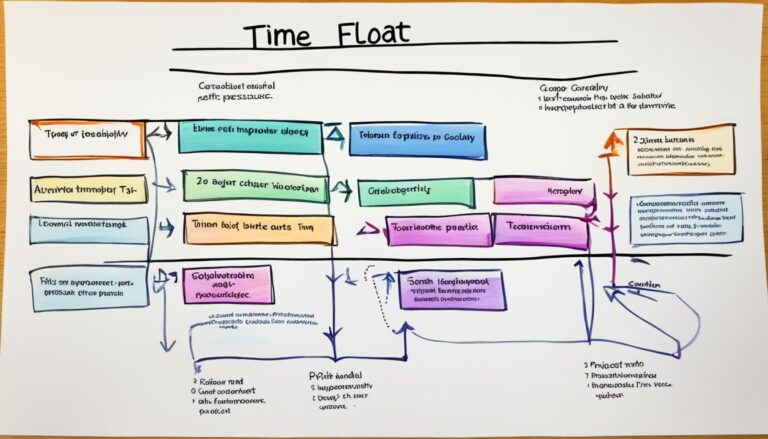Unlock Potential with Parkinson’s Law Mastery

Have you ever wondered why some people seem to effortlessly accomplish more in less time, while others struggle to complete even simple tasks? It’s time to unlock your true potential and revolutionize the way you approach work. Let’s delve into the intriguing world of Parkinson’s Law and discover how understanding and applying it can maximize your efficiency, conquer procrastination, and transform your productivity.
Key Takeaways:
- By mastering Parkinson’s Law, you can maximize your efficiency and conquer procrastination.
- Implementing Parkinson’s Law in business can lead to increased productivity and improved time management skills.
- Practical strategies such as setting clear deadlines and creating distraction-free zones can help apply Parkinson’s Law effectively.
- Embracing urgency and tapping into the hidden potential of Parkinson’s Law can leave you with extra time for leisure or new projects.
- Combining Parkinson’s Law with other principles, such as the Yerkes-Dodson Law, can optimize performance and prevent burnout.
The Two Pizza Team Rule: Embracing Constraints for Efficiency
When it comes to optimizing team efficiency, sometimes less is more. The “Two Pizza Team” rule, introduced by Jeff Bezos, emphasizes the power of small, focused teams in achieving remarkable results. This rule suggests that teams should be small enough to be fed with just two pizzas, preventing unnecessary bloat and enabling agility.
By embracing constraints, such as limiting team size, organizations can avoid violating Parkinson’s Law and maintain high levels of productivity. Large corporate structures that ignore the Two Pizza Team rule often experience decreased agility, increased bureaucracy, and decreased efficiency.
When teams are too large, individuals tend to become complacent, relying on others to carry the weight. In small teams, however, each member plays a vital role and takes ownership of their responsibilities. This sense of accountability drives collaboration, innovation, and a shared sense of purpose.
The Two Pizza Team rule also fosters effective communication and decision-making. With fewer members, discussions stay focused and decisions are made more swiftly. This allows teams to adapt quickly to changing circumstances and take advantage of emerging opportunities.
By embracing the constraint of small teams, organizations can unleash the power of Parkinson’s Law and tap into the efficiency and agility it offers. This not only drives productivity but also empowers employees to make a meaningful impact and achieve exceptional results.

Advantages of the Two Pizza Team Rule
- Enhanced focus and accountability.
- Improved communication and decision-making.
- Faster adaptability and flexibility.
- Increased innovation and creativity.
- Boosted employee engagement and satisfaction.
Comparison: Large vs. Two Pizza Team Structure
| Large Team Structure | Two Pizza Team Structure |
|---|---|
| Slow decision-making process. | Quick and efficient decision-making. |
| Decreased collaboration and innovation. | Enhanced collaboration and innovation. |
| Bureaucracy and red tape. | Streamlined processes and fewer barriers. |
| Individuals lose ownership and accountability. | Increased ownership and accountability. |
| Lower agility and adaptability. | Heightened agility and adaptability. |
Tapping into Parkinson’s Law for Enhanced Productivity
Parkinson’s Law can be a powerful ally in achieving efficiency and enhancing productivity. By understanding and applying Parkinson’s Law, you can unlock your full potential and accomplish more in less time. By setting deadlines and constraints for your tasks, you can tap into the hidden potential of Parkinson’s Law, which states that work expands to fill the time available for its completion.
Implementing Parkinson’s Law allows you to complete work more swiftly and effectively, leaving you with extra time for leisure or new projects. By embracing the principles of Parkinson’s Law, you can overcome procrastination, improve time management skills, and boost your overall productivity.
To apply Parkinson’s Law effectively, consider the following practical strategies:
- Set Clear Deadlines: Clearly define and set realistic deadlines for your tasks and projects. Deadlines create a sense of urgency and help you stay focused and motivated.
- Break Down Tasks: Divide overwhelming goals into smaller, manageable tasks. This makes them easier to tackle and ensures steady progress.
- Time Blocking: Allocate dedicated time blocks for specific tasks. This helps eliminate distractions and promotes deep focus.
- Create a Distraction-Free Zone: Designate a workspace free from distractions, such as noise or interruptions. This will help you maintain concentration and productivity.
By incorporating these strategies into your workflow, you can harness the power of Parkinson’s Law, overcome its potential limitations, and boost your productivity to new heights.
Remember, Parkinson’s Law is not only a descriptive principle but also a powerful tool to enhance your productivity. By embracing its principles and implementing practical strategies, you can efficiently manage your time and accomplish more with less effort. Stay focused, set deadlines, and tap into the hidden potential of Parkinson’s Law to unlock your true productivity.
Practical Strategies to Implement Parkinson’s Law
Now that you understand the power of Parkinson’s Law and its potential to boost productivity, it’s time to explore practical strategies to apply this principle effectively. By implementing these strategies, you can overcome the challenges posed by Parkinson’s Law and achieve remarkable results.
Set Clear, Realistic Deadlines
One of the key tactics in unlocking the power of Parkinson’s Law is to set clear, realistic deadlines for your projects. By doing so, you create a sense of urgency and focus that prevents tasks from expanding beyond necessity. Hold yourself accountable to these deadlines and treat them as sacred commitments.
Divide Overwhelming Goals
Large and overwhelming goals tend to consume enormous amounts of time, leading to procrastination and inefficiency. Overcome this challenge by breaking down these goals into smaller, manageable tasks. Assign a timeframe for each sub-task and work toward completing them systematically. This approach helps you maintain momentum and prevent work from expanding beyond what is necessary.
Use Time-Blocking Techniques
Time-blocking is a powerful technique that allows you to dedicate focused periods of time to specific tasks. By allocating specific time slots to work on particular assignments, you create structure and eliminate distractions. This strategy enables you to maximize productivity and ensure that work doesn’t expand beyond the allotted time.
Create a Distraction-Free Zone
Minimizing interruptions is essential when implementing Parkinson’s Law. Create a dedicated workspace that is free from distractions. Turn off notifications on your electronic devices, close unnecessary tabs on your computer, and communicate your need for uninterrupted time to colleagues or family members. By eliminating distractions, you can maintain focus and prevent work from expanding unnecessarily.
Treat Deadlines as Sacred Commitments
Embrace a sense of urgency when it comes to meeting your deadlines. Treat them as sacred commitments that cannot be compromised. By instilling a strong sense of responsibility and accountability, you can combat procrastination and ensure that work is completed within the allocated time frames.
Implementing these practical strategies will help you apply Parkinson’s Law effectively and overcome its challenges. By setting clear deadlines, dividing overwhelming goals, utilizing time-blocking techniques, creating a distraction-free zone, and treating deadlines as sacred commitments, you can maximize your productivity and achieve remarkable results.
| Practical Strategies to Implement Parkinson’s Law | Benefits |
|---|---|
| Set clear, realistic deadlines | Creates a sense of urgency and prevents work from expanding unnecessarily |
| Divide overwhelming goals | Prevents procrastination and inefficiency by breaking down tasks into manageable sub-tasks |
| Use time-blocking techniques | Dedicate focused periods to specific tasks, eliminating distractions and maximizing productivity |
| Create a distraction-free zone | Minimize interruptions and maintain focus on the task at hand |
| Treat deadlines as sacred commitments | Combat procrastination and ensure timely completion of tasks |

Maximizing Results with Parkinson’s Law
Implementing Parkinson’s Law can have a profound impact on your productivity and time management. By understanding and applying this principle, you can unlock your true potential and achieve remarkable results.
Parkinson’s Law helps you avoid unnecessary delays and distractions, allowing you to accomplish more in less time. It compels you to focus on the most crucial tasks, improving your prioritization and concentration. With efficient time allocation, you can strike a better work-life balance and enhance your overall time management skills.
By harnessing the power of Parkinson’s Law, you can experience the following benefits:
- Increased Productivity: Parkinson’s Law drives you to work more efficiently and avoid wasting time on non-essential activities.
- Improved Time Management: By setting clear deadlines and constraints, you become more intentional with your time and make effective use of every moment.
- Focus on What Matters: Parkinson’s Law compels you to prioritize tasks based on importance, ensuring that you tackle the most essential ones first.
- Reduced Procrastination: The sense of urgency created by Parkinson’s Law helps you overcome procrastination and stay on track to achieve your goals.
By embracing Parkinson’s Law, you can maximize your productivity and achieve extraordinary outcomes in both your professional and personal life.

| Benefits of Implementing Parkinson’s Law | Examples |
|---|---|
| Increased productivity: | By setting deadlines and allocating time efficiently, you can accomplish tasks more quickly. |
| Improved time management: | Setting clear deadlines helps you stay focused and avoid time-wasting activities. |
| Enhanced prioritization: | Parkinson’s Law compels you to focus on the most important tasks, improving your decision-making. |
| Reduced procrastination: | The sense of urgency created by Parkinson’s Law combats procrastination and keeps you motivated. |
The Power of Parkinson’s Law and Yerkes-Dodson Law Combined
Parkinson’s Law and the Yerkes-Dodson Law can work hand in hand to optimize performance and productivity. By understanding and applying both principles, you can unlock your true potential and achieve exceptional results.
Understanding Parkinson’s Law
Parkinson’s Law helps set realistic yet challenging time frames for completing tasks, which promotes efficiency. It highlights the tendency for work to expand to fill the time available for its completion.
By embracing Parkinson’s Law, you can avoid unnecessary delays and focus on accomplishing tasks within specific time constraints. This approach not only enhances efficiency but also encourages better time management.
Applying Parkinson’s Law in Business
Parkinson’s Law is particularly relevant in a business setting. By setting clear deadlines and defining the scope of work, you can prevent excessive task prolongation and minimize unnecessary distractions.
Let’s take a look at an example of Parkinson’s Law in business:
| Company | Description | Outcome |
|---|---|---|
| ABC Technologies | Implemented time-bound task assignments and regular progress updates | Enhanced productivity, improved adherence to deadlines, and increased overall efficiency |
| XYZ Corporation | Allowed indefinite project timelines without clear deadlines | Resulted in project delays, decreased productivity, and compromised deliverables |
As demonstrated in the example above, embracing Parkinson’s Law in business can yield positive results, while deviating from it can lead to less desirable outcomes.
Understanding the Yerkes-Dodson Law
The Yerkes-Dodson Law complements Parkinson’s Law by helping individuals identify their optimal level of stress or arousal for peak performance. It suggests that too little or too much stress can hinder productivity, while an optimal level can lead to maximum efficiency.
By understanding your personal stress-response curve and finding the right balance, you can achieve optimal performance and avoid burnout.

By combining the principles of Parkinson’s Law and the Yerkes-Dodson Law, you can maintain your mental well-being, operate at peak efficiency, and avoid burnout. Striking a balance between setting challenging yet achievable deadlines and managing stress levels is key to optimizing performance.
Striking the Balance between Time Management and Stress Management
A balanced approach between time management and stress management is crucial for optimal productivity. While the implementation of Parkinson’s Law can drive efficiency and productivity, it’s essential to avoid excessive stress and burnout in the pursuit of challenging goals.
By striking the right balance between setting ambitious deadlines and ensuring they are achievable, individuals can overcome the potential negative effects of Parkinson’s Law. Short, well-defined deadlines can create a sense of urgency and focus, driving productivity. However, when deadlines are overly aggressive or unrealistic, it can lead to increased stress levels and decreased overall performance.
Leaders play a crucial role in promoting a healthy, productive balance within their teams. They should prioritize efficiency over long hours and serve as role models for maintaining a sustainable work-life balance. Encouraging open communication, providing support, and fostering a culture of well-being can help individuals overcome the challenges presented by Parkinson’s Law.
By finding the right equilibrium between time management and stress management, individuals can harness the power of Parkinson’s Law while preserving their mental and physical well-being. By prioritizing self-care and maintaining a healthy work-life balance, individuals can unlock their maximum potential and thrive in both professional and personal domains.
Embracing a balanced approach to time management and stress management not only enhances productivity but also contributes to long-term success and overall well-being. It allows individuals to overcome the challenges posed by Parkinson’s Law and achieve sustainable high performance in their personal and professional lives.
Conclusion
Unlocking your productivity potential is within your reach when you harness the power of Parkinson’s Law. By setting challenging deadlines and embracing constraints, you can conquer procrastination and inefficiency that often hold you back. Parkinson’s Law allows you to transform your efficiency, productivity, and creativity, enabling you to make the most of your time.
However, finding the right balance between time management and stress management is essential for long-term success. While setting ambitious goals and deadlines can drive efficiency, it’s crucial to avoid overly aggressive timeframes that may lead to stress and burnout. Prioritizing a healthy work-life balance and modeling this behavior for your teams will set a foundation for sustained productivity.
Remember, by applying Parkinson’s Law with strategic time management, you can unlock your true potential. Embrace the power of deadlines, break down tasks, and create a focus-enhancing environment. With these practices in place, you’ll be on your way to maximizing your efficiency, productivity, and creativity, while maintaining a well-balanced and fulfilling life.






